Abstract
OBJECTIVES. The purpose of this study was to determine the relative importance adolescents place on preventive health behaviors. METHODS. Data were from a survey of California adolescents (n = 5040). Respondents were asked how important it was to their peers to avoid drugs, marijuana, cigarettes, heavy drinking, and drinking and driving and to maintain seat belt use, fitness, weight control, and healthy eating habits. Results were compared with data from a similar national survey (n = 6126). RESULTS. California teenagers perceived that their peers gave top priority to weight control: 85% of California teenagers believed that weight control was of high concern to girls in their age group. Avoiding drugs, not drinking and driving, and maintaining fitness ranked in the top five behaviors. The lowest ranked health behaviors were seat belt use, heavy drinking, and, last, eating healthily. In the national survey, healthy eating also ranked last. Although not identical in rank, teenage priorities for other health behaviors were consistent with the California results. CONCLUSION. Efforts are needed to bring adolescent health norms more into line with the objective risks of their health choices during this critical period of socialization.
Full text
PDF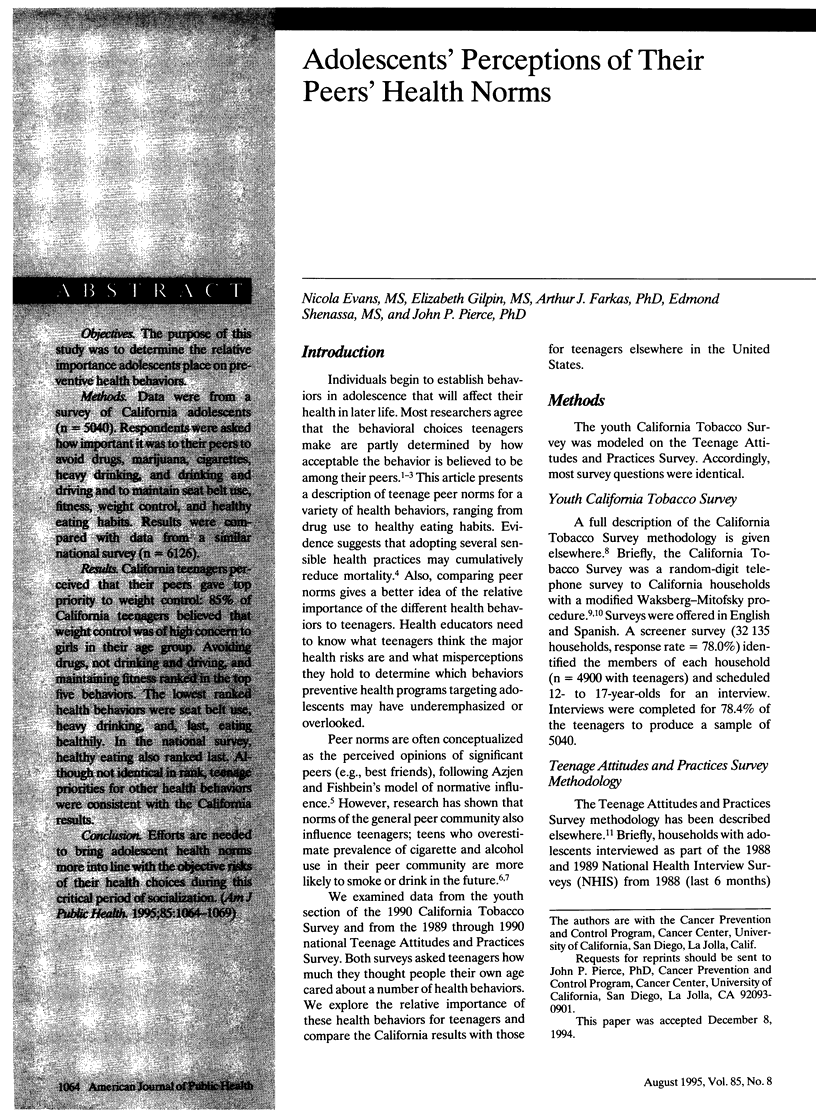
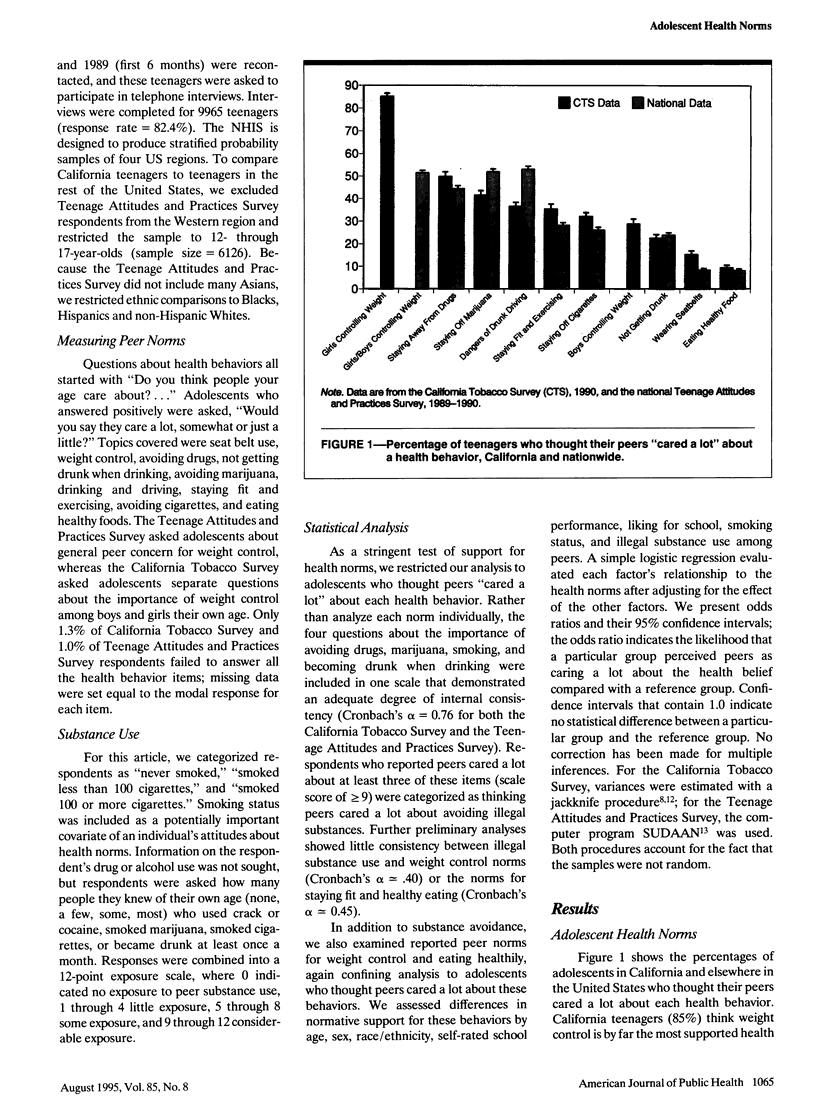
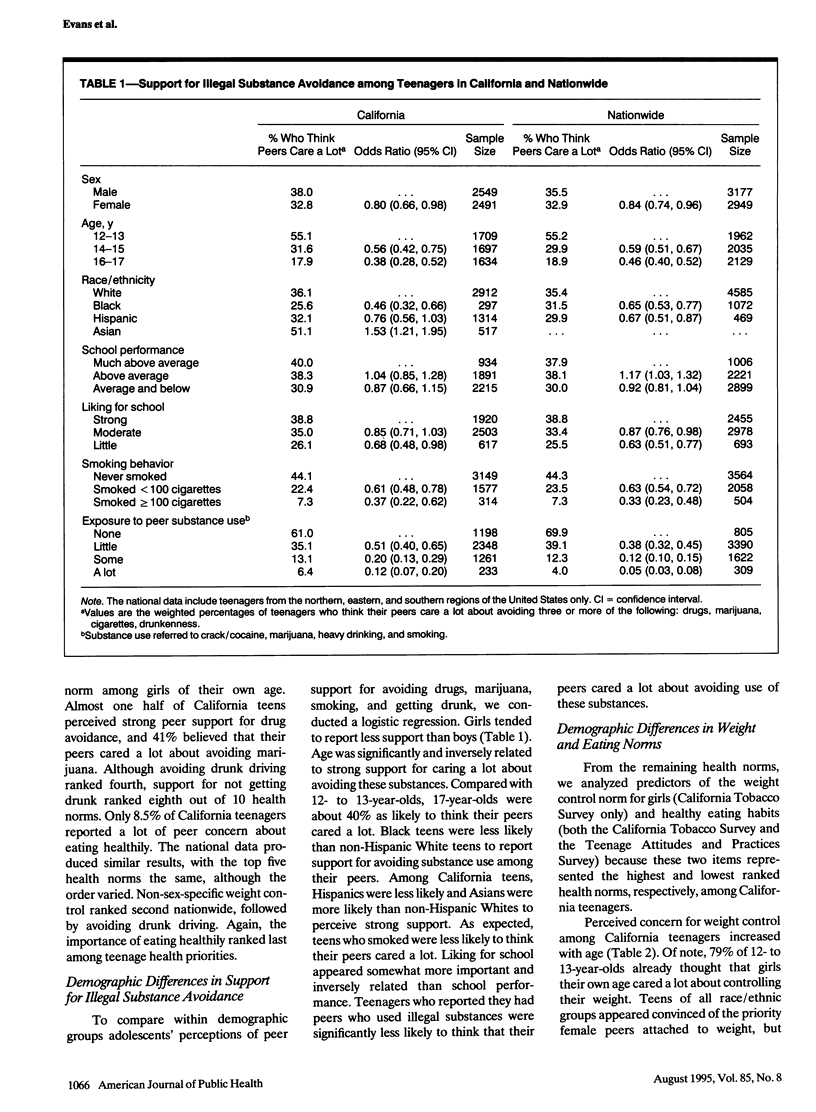
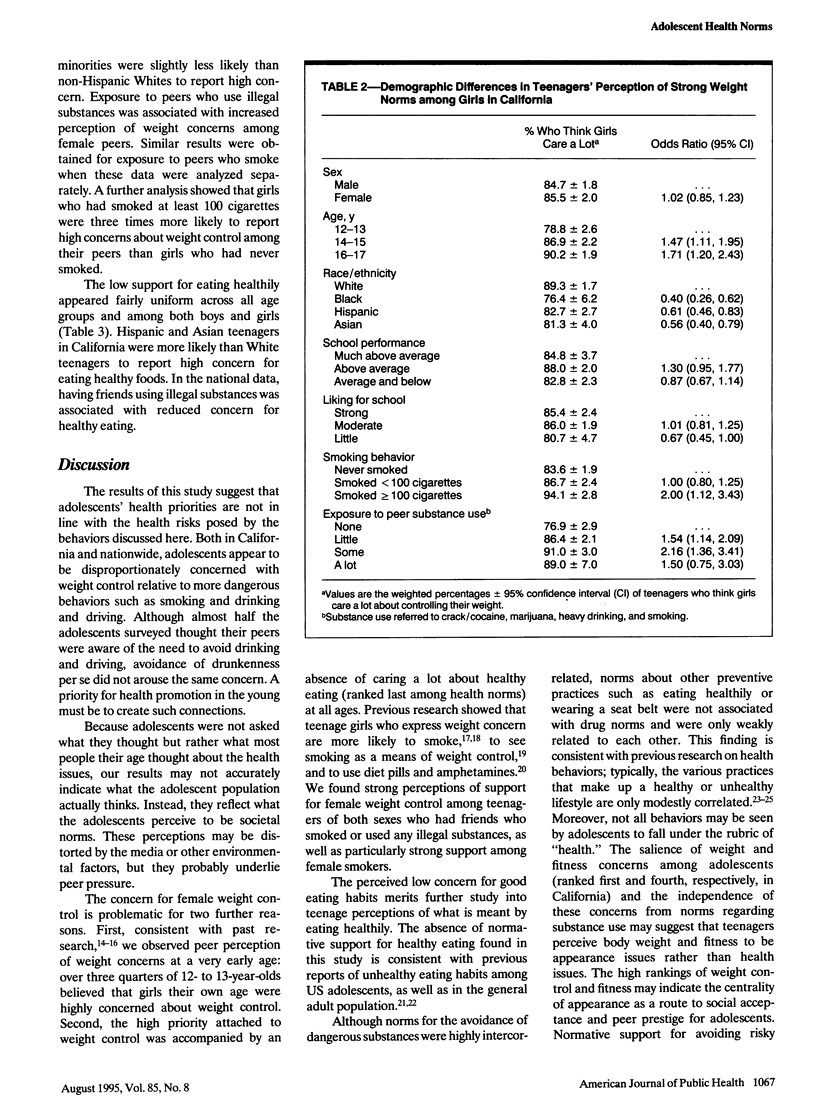
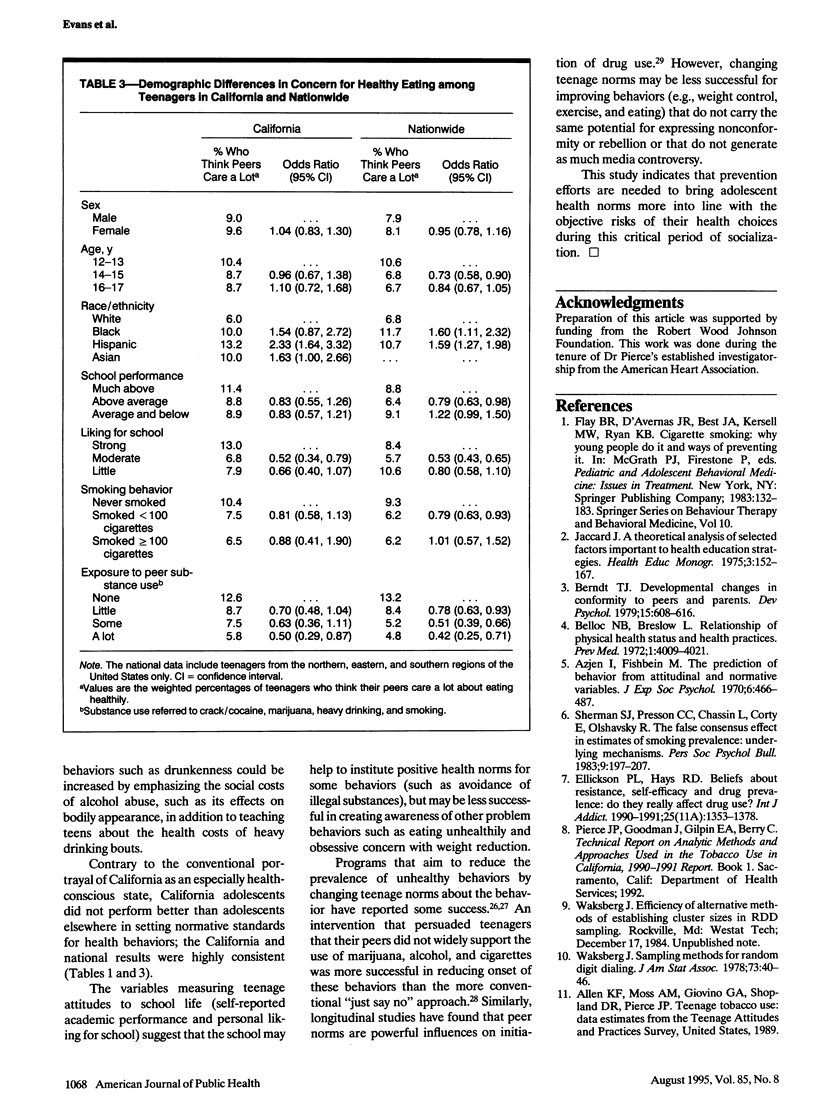
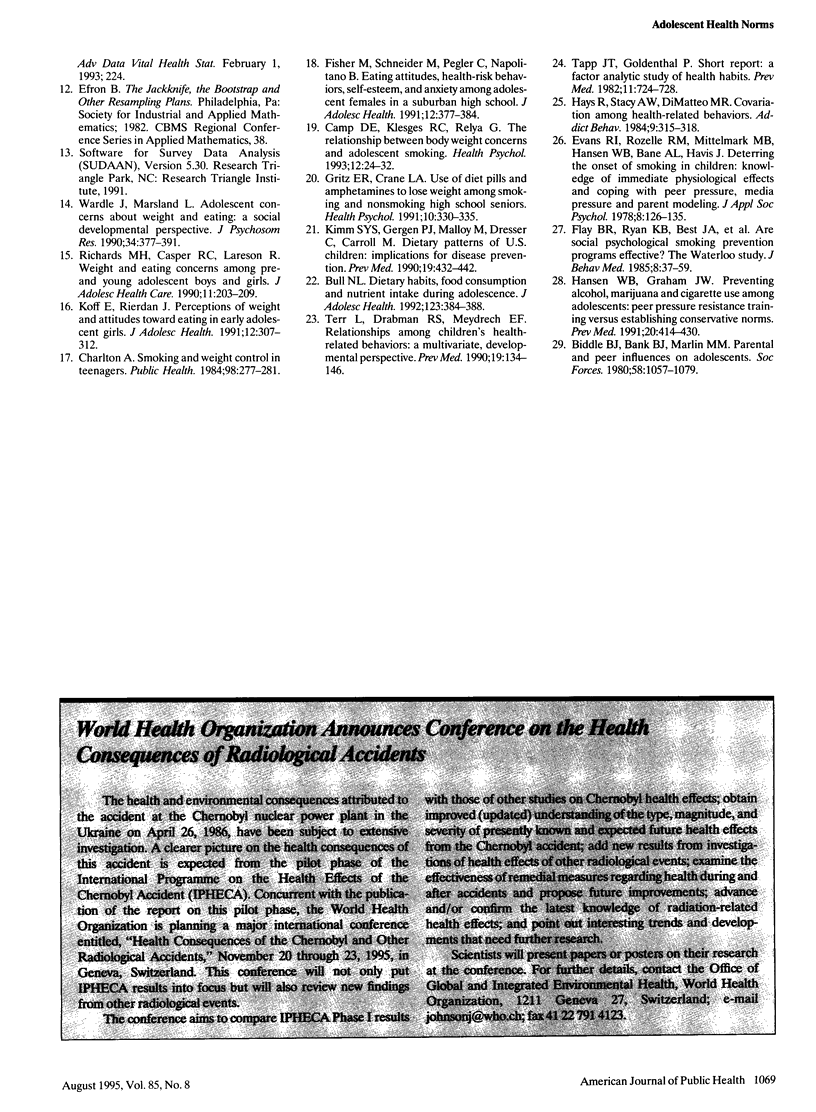
Selected References
These references are in PubMed. This may not be the complete list of references from this article.
- Bull N. L. Dietary habits, food consumption, and nutrient intake during adolescence. J Adolesc Health. 1992 Jul;13(5):384–388. doi: 10.1016/1054-139x(92)90034-9. [DOI] [PubMed] [Google Scholar]
- Camp D. E., Klesges R. C., Relyea G. The relationship between body weight concerns and adolescent smoking. Health Psychol. 1993 Jan;12(1):24–32. doi: 10.1037//0278-6133.12.1.24. [DOI] [PubMed] [Google Scholar]
- Charlton A. Smoking and weight control in teenagers. Public Health. 1984 Sep;98(5):277–281. doi: 10.1016/s0033-3506(84)80003-7. [DOI] [PubMed] [Google Scholar]
- Ellickson P. L., Hays R. D. Beliefs about resistance self-efficacy and drug prevalence: do they really affect drug use? Int J Addict. 1990;25(11A):1353–1378. doi: 10.3109/10826089009068468. [DOI] [PubMed] [Google Scholar]
- Fisher M., Schneider M., Pegler C., Napolitano B. Eating attitudes, health-risk behaviors, self-esteem, and anxiety among adolescent females in a suburban high school. J Adolesc Health. 1991 Jul;12(5):377–384. doi: 10.1016/0197-0070(91)90051-m. [DOI] [PubMed] [Google Scholar]
- Flay B. R., Ryan K. B., Best J. A., Brown K. S., Kersell M. W., d'Avernas J. R., Zanna M. P. Are social-psychological smoking prevention programs effective? The Waterloo study. J Behav Med. 1985 Mar;8(1):37–59. doi: 10.1007/BF00845511. [DOI] [PubMed] [Google Scholar]
- Gritz E. R., Crane L. A. Use of diet pills and amphetamines to lose weight among smoking and nonsmoking high school seniors. Health Psychol. 1991;10(5):330–335. doi: 10.1037//0278-6133.10.5.330. [DOI] [PubMed] [Google Scholar]
- Hansen W. B., Graham J. W. Preventing alcohol, marijuana, and cigarette use among adolescents: peer pressure resistance training versus establishing conservative norms. Prev Med. 1991 May;20(3):414–430. doi: 10.1016/0091-7435(91)90039-7. [DOI] [PubMed] [Google Scholar]
- Hays R., Stacy A. W., DiMatteo M. R. Covariation among health-related behaviors. Addict Behav. 1984;9(3):315–318. doi: 10.1016/0306-4603(84)90028-5. [DOI] [PubMed] [Google Scholar]
- Jaccard J. A theoretical analysis of selected factors important to health education strategies. Health Educ Monogr. 1975 Summer;3(2):152–167. doi: 10.1177/109019817500300201. [DOI] [PubMed] [Google Scholar]
- Kimm S. Y., Gergen P. J., Malloy M., Dresser C., Carroll M. Dietary patterns of U.S. children: implications for disease prevention. Prev Med. 1990 Jul;19(4):432–442. doi: 10.1016/0091-7435(90)90041-h. [DOI] [PubMed] [Google Scholar]
- Koff E., Rierdan J. Perceptions of weight and attitudes toward eating in early adolescent girls. J Adolesc Health. 1991 Jun;12(4):307–312. doi: 10.1016/0197-0070(91)90004-6. [DOI] [PubMed] [Google Scholar]
- Richards M. H., Casper R. C., Larson R. Weight and eating concerns among pre- and young adolescent boys and girls. J Adolesc Health Care. 1990 May;11(3):203–209. doi: 10.1016/0197-0070(90)90349-7. [DOI] [PubMed] [Google Scholar]
- Tapp J. T., Goldenthal P. A factor analytic study of health habits. Prev Med. 1982 Nov;11(6):724–728. doi: 10.1016/0091-7435(82)90035-4. [DOI] [PubMed] [Google Scholar]
- Terre L., Drabman R. S., Meydrech E. F. Relationships among children's health-related behaviors: a multivariate, developmental perspective. Prev Med. 1990 Mar;19(2):134–146. doi: 10.1016/0091-7435(90)90015-c. [DOI] [PubMed] [Google Scholar]
- Wardle J., Marsland L. Adolescent concerns about weight and eating; a social-development perspective. J Psychosom Res. 1990;34(4):377–391. doi: 10.1016/0022-3999(90)90061-8. [DOI] [PubMed] [Google Scholar]


